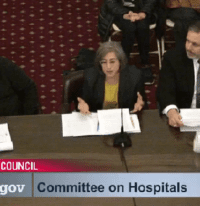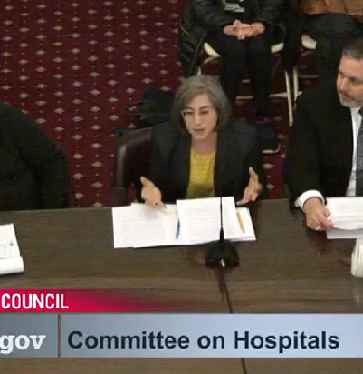PCDC Calls for Strengthening Primary Care Infrastructure in NYC Council Testimony


 PCDC CEO Louise Cohen testified before the New York City Council Committee on Hospitals today, voicing support for strengthening the City’s primary care infrastructure in partnership with NYC Health + Hospitals (H+H).
PCDC CEO Louise Cohen testified before the New York City Council Committee on Hospitals today, voicing support for strengthening the City’s primary care infrastructure in partnership with NYC Health + Hospitals (H+H).
“PCDC strongly supports the investments made by H+H, the City Council, and the de Blasio administration to expand and build new community health centers to connect more New Yorkers to accessible quality primary care under the One New York and Caring Neighborhoods initiatives,” Cohen said.
The full testimony follows.
___________________________________________________________________________________________
Thank you for the opportunity to testify before the committee today. I am Louise Cohen, Chief Executive Officer of the Primary Care Development Corporation (PCDC). Founded in 1993 by Mayor David Dinkins and a visionary group of health and civic leaders, PCDC is a non-profit organization and Community Development Financial Institution (CDFI) that has partnered with the City of New York for 25 years to catalyze excellence in primary care for millions of New Yorkers in neighborhoods across all five boroughs.
Our mission is to create healthier and more equitable communities by building, expanding, and strengthening primary care through strategic capital investment, practice transformation, and policy and advocacy. We believe every New Yorker in every neighborhood should have access to high quality primary care.
We have worked with over 400 health care sites across New York City and hundreds more in the Empire State, including seven DSRIP (Delivery System Reform Incentive Program) Performing Provider Systems (PPS) in all corners of the state. We have provided financing for community health centers in all five boroughs – and for half of all Federally Qualified Health Centers (19 out of 39) in the City.
Nationally, we have invested almost $875 million in 130 primary care health center projects, leveraging more than $5 of private investment for each $1 of public investment. These projects have provided primary care access for millions of patients, created more than 8,500 jobs in low-income communities, and transformed more than 1.6 million square feet of space. We have assisted more than 450 practices to become recognized as Patient Centered Medical Homes. PCDC has also trained and coached more than 7,000 health workers to deliver superior patient-centered care, including at NYC Health + Hospitals, where we have provided technical assistance for ambulatory care redesign for more than 15 years.
Twenty-five years ago when PCDC was founded, New York City’s primary care landscape was bleak. A front page New York Times story reported on a “severe deficit of doctors in poor urban neighborhoods” and a devastating study that found “only 28 properly qualified doctors to serve a population of 1.7 million in nine low-income neighborhoods in Harlem, north central Brooklyn and the South Bronx.” The 1993 story also highlighted PCDC’s founding to finance health facilities to bring high quality and culturally competent care to underserved communities through a $17 million investment by the City. At the same time, then-Mayor David Dinkins also provided the Health and Hospitals Corporation with $48 million in capital and operating funds to build 20 family health care centers in 13 of New York City’s most medically underserved communities in what was then called CommuniCare, and which is now known as Gotham Health.
While New York City’s primary care infrastructure has improved dramatically over the last 25 years, looming federal actions are creating a bleak outlook for the city’s health care safety net, directly undermining health care access, coverage, and service delivery for millions of New Yorkers. Now is a critical time to examine and work to accelerate access to quality health care for all New Yorkers. We thank the City Council for today’s hearing on the status of the One New York: Health Care for Our Neighborhoods transformation plan for NYC Health + Hospitals to support our essential public health care system and to help expand comprehensive health care, especially in high-need communities.
PCDC applauds the vision of NYC Health + Hospitals’ (H+H) new president Dr. Mitchell Katz to focus on primary care. His commitment to “turn the nation’s largest public health care network into an agency that focuses less on hospital care and more on primary care,” is right in keeping with PCDC’s vision and H+H’s historic mission as not only a safety net provider but also to improve the health of New York City communities.
At PCDC, we believe that primary care is the heart of the health care system. High quality, affordable, accessible, and well-resourced primary care is the key to healthier people and communities and to achieving health equity. Studies show that primary care can bend the health care cost curve – but the costs for primary care will go up before total cost of care goes down. Primary care centers – including those of H+H — are anchor institutions in communities, providing valuable jobs and good career paths.
H+H has been a leader in what health system reform – or what many people refer to as “transformation,” meaning transformation from a reimbursement system driven by patient visits to one that is rewarded for access, quality and patient and provider satisfaction. Yesterday’s Health Affairs blog post by H+H’s Chief Population Health Officer and PCDC Board Member David Chokshi demonstrates the type of action that the rest of the health system needs to emulate: the objective assessment of primary care along a variety of key domains of access, quality, connectivity, innovation, patient experience and patient safety, cost, and outcomes, that is then used to spur additional movement towards a high performing, equitable, and cost effective primary care system both for H+H’s own primary care and for its network of primary care partners. PCDC is proud to be a technical assistance provider for H+H’s OneCity PPS network.
The entire premise of health system reform rests on a robust primary care system.
Primary care makes the difference between a life-threatening chronic condition and a manageable or treatable condition. Primary care is the first point of comprehensive care, addressing all that contributes to a person’s health and well-being, from childhood through old age. It includes family and adult medicine as well as community behavioral health, women’s health care, and geriatrics. It is screening, diagnosis, and treatment; referral to and coordination with other care settings and providers; health education, preventive services, and more. It is the steady, incremental care provided in doctors’ offices, large group practices, federally qualified health centers, women’s reproductive health centers, and hospital ambulatory care.
Without primary care, families risk illness that can threaten their well-being and financial security as well as worsen health, social, and economic inequities.
In this light, it’s easy to see why PCDC considers access to this kind of primary care to be a social determinant of health. We believe that many primary care providers – including and especially those at H+H — are working hard to provide this kind of care in many communities.
However, today in our health care system, primary care gets about 7 cents on the health care dollar. Just reporting quality metrics can cost $50,000 per provider per year. Achieving Patient Centered Medical Home recognition costs about $14,000 per FTE and to maintain it, another $8,000 monthly.
Today, there are additional resources from the New York State Delivery System Reform Incentive Program, but that program will end soon and those dollars will not be sufficient to maintain the system into the future. As the health reform discussion has evolved, primary care is expected to enter into new payment arrangements aligned with the outcomes we all want to see. The One New York report, in almost every strategy, highlights the need to invest in patient centered coordinated care that improves the health of communities. PCDC believes that this will be accomplished through H+H’s own efforts and the work of many partners, including ourselves. What this requires is upfront, robust, and steady payment. We applaud the Council and the Administration for your strong financial commitment to the vital health care system that is H+H.
PCDC strongly supports the investments made by H+H, the City Council, and the de Blasio administration to expand and build new community health centers to connect more New Yorkers to accessible quality primary care under the One New York and Caring Neighborhoods initiatives. The City and H+H’s commitment to build five new primary care centers in Manhattan, Queens, Brooklyn and Staten Island, as well as expanding services at six existing primary care sites in the Bronx, Brooklyn and Queens is critically important. This, along with the Caring Neighborhoods support for non-H+H facilities – in which PCDC has been a financing partner with the City – has already brought significant new primary care capacity to communities. This is a long-lasting legacy to improve the health of poorer communities in New York City, and one which we applaud.
PCDC has been a strong and willing partner to the City across administrations. In addition to our technical assistance capacity, we have a variety of financing mechanisms and technical assistance available to support new or renovated primary care facilities – which we have used to support new primary care facilities in East New York, the Rockaways, the Bronx, East Harlem, Harlem, and Chelsea, to name a few. We are most successful when we leverage our resources to partner with the City and other entities to jointly finance projects for community primary care providers without recourse to bank capital. In particular, we believe that leveraging grant capital through the City, State or Federal government by providing a percentage of debt to finance key projects ensures that scarce public resources are matched with private dollars to finance more and larger projects.
We strongly support the One New York recommendation to invest in new community-based care in underserved neighborhoods and to build primary care sites on vacant and under-utilized parcels on H+H campuses and in the community. We stand ready to partner with the Council, H+H, and the Administration, to make this strategy a reality.
Thank you for this opportunity to testify before the City Council Committee on Hospitals. We look forward to working with you and H+H to strengthen the City’s primary care infrastructure.